► CAR’s best electric family cars 2025
► Practical EVs with a long range
► We rank the best for any budget
Over the past few years the choice of electric vehicles (EVs) on offer has increased significantly, and that means there are now several electric family cars to choose from in 2025. There are more family-orientated EVs are going on sale every month – and they’re getting cheaper, too. And some of these family cars are among the best electric cars on the market right now.
While EVs can still be pricey, more and more options are being launched for those looking for something for the family. Electric cars are, in some cases, more practical and spacious than cars with engines due to how they’re constructed, allowing more rear space or a more easily accessible boot area, for instance. Even some small electric cars can be suitable for family life.
The best electric family cars at a glance:
- Best electric family car for value: MG 4 – Find out more
- Best electric family car for style: Hyundai Ioniq 5 – Find out more
- Best electric family car for space and retro looks: VW ID. Buzz – Find out more
What’s the best family electric car in the UK right now? Depends what kind of family car you’re after. Are you a small family looking for a sharp-looking baby crossover SUV? Are you a bigger family more focused on fitting seven passengers inside? Or do you want one electric car to rule them all, being your sharp-steering performance car as much as an EV for loading up?
We’ve listed the best electric family cars from smallest to biggest to help you out.
Best electric family cars in 2025
Peugeot e-2008
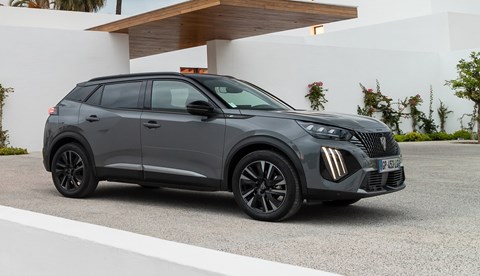
Best for those looking for a stylish electric SUV with a plush interior and a soft ride
Pros: Distinctive design, quality interior, and a comfortable ride
Cons: Over-light steering and vague handling
Why are we recommending the Peugeot e-2008? Because it’s a good family car, suiting the needs of small families looking for a little crossover style. The boot is larger than its Mokka Electric sibling, and it drives sweetly. Current range claims top out at 251 miles on a charge, which equates to a real-world 180 miles or so.
The latest model boasts a bold new look in line with Peugeot’s latest models and retains the plush interior we’ve come to love from the 2008 – it feels much more expensive than it is.
Read our full Peugeot e-2008 review
MG 4
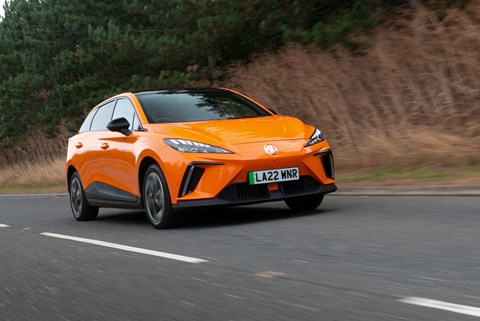
Best for budget-conscious buyers seeking a modern and efficient electric vehicle
Pros: Sharp looks, good to drive, roomy and efficient
Cons: Plasticky interior, iffy infotainment software
The MG 4 EV hatchback, priced remarkably at £25,995 for the entry-level SE with the Standard Range battery, is poised to disrupt the EV market. It directly challenges the VW ID.3 but does so at a significantly lower price point. The MG 4 EV offers up to 281 miles of range with its Long Range 64kWh battery, and a high-performance AWD model boasting a staggering 443bhp is also available.
In terms of space, the MG 4 EV comfortably accommodates four adults and offers a spacious boot with additional storage beneath the floor. The vehicle’s affordability extends to finance packages, making it an exceptional value proposition in the EV market.
A compelling choice for those seeking a modern, efficient, and affordable electric vehicle.
Read our full MG 4 EV review
Tesla Model 3
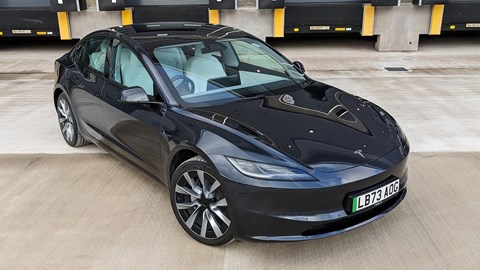
Best for those seeking a pioneering electric vehicle with a blend of performance, tech, and range
Pros: Substantial real-world battery range, spacious interior, advanced driver-assistance
Cons: Love/hate interior, not the best aftersales setup
Although it’s now overshadowed in sales by the Model Y, the Model 3 remains a significant player in the EV market, even with the emergence of rivals like the Polestar 2, Hyundai Ioniq 6, Kia EV6, and BMW i4. In 2025, three variants are available: the standard rear-drive Model 3 priced at £42,990, the all-wheel-drive Long Range at £50,990, and the Performance version at £57,990.
The Model 3’s design is unmistakably Tesla, with its distinctive rear light bar and minimalist interior dominated by a 15.0-inch touchscreen. The driving experience is characterized by silence and remarkable speed, with the Performance variant boasting a 0-60mph time of just 3.1 seconds.
What’s more, owning a Tesla gives you access to Tesla Superchargers, and its cars get regular software updates that unlock new features. The saloon-like boot might not be as accessible as some on this list overall space is good for family buyers.
Read our full Tesla Model 3 review
Kia Niro EV
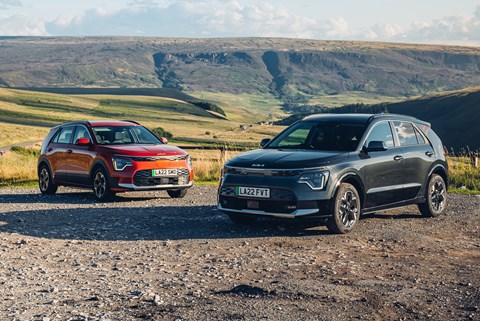
Best for those who want reliable, practical EV with a focus on everyday usability
Pros: Futuristic looks, sweet ride, roomy, efficient
Cons: Plain to drive, some materials used don’t feel premium
The all-new second-generation Kia Niro EV, priced from £34,995, has undergone significant changes, making for a smarter EV both inside and out. Although it bears a resemblance to the older Niro, it now sports a design more akin to the cutting-edge Kia EV6.
The new Niro EV is slightly larger, with an enhanced battery capacity of 64.8kWh, promising a range of up to 285 miles. The vehicle’s performance has been slightly toned down, with a torque of 188lb ft and a 0-62mph acceleration time of 7.8 seconds.
The interior to match that’s filled with neat features (like Quiet Mode for a quick switching-off of the rear audio speakers when the kids are napping, and it’s still got lots of space: the not-quite-hatchback, not-quite-SUV shape also means headroom for adults in the second row and a big boot. It may be a bit boring to drive, but it’s smooth and manages good e-range claims.
Read our full Kia Niro EV review
Skoda Enyaq
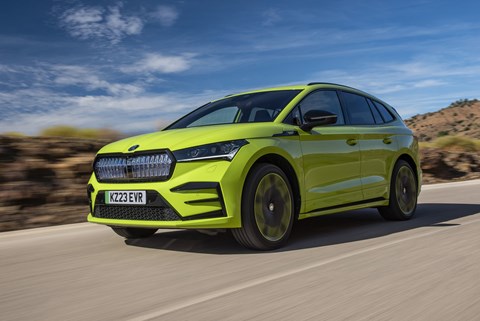
Best for those seeking a luxurious, spacious, and efficient SUV with a touch of elegance
Pros: Practical, smooth to drive, good value
Cons: Bland to drive, infotainment sometimes fiddly
It wouldn’t be a family car list without a Skoda in it. Naturally, Skoda’s done its EV properly and feels like a step up in terms of quality for the brand, too. Rear space is good (provided you go for the regular Enyaq and not the Coupe with its more sloped roofline), and the boot is big. Plus, the Enyaq comes with all the usual Simply Clever tricks Skodas have always had.
It’s a pivotal vehicle for Skoda, marking its foray into the electric realm. The Enyaq offers a range of up to 333 miles, with real-world figures hovering around 250 miles. The SUV’s design is a blend of the Octavia Estate and Kodiaq, while on the road, the Enyaq impresses with its comfort, space, and long-distance cruising capabilities. The interior is better than you’d think, featuring a vast 13.0-inch touchscreen infotainment display and a plethora of modern amenities.
While not the most thrilling thing to drive, it’s a better overall package (with a slightly, but only slightly, less frustrating infotainment system) than its VW ID.4 compatriot. And there’s even a vRS version (pictured above) if you fancy some extra punch.
Read our full Skoda Enyaq review
Hyundai Ioniq 5
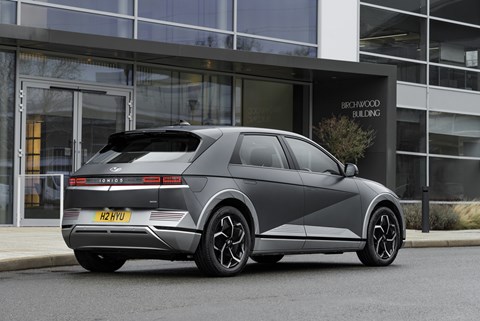
Best for those seeking a stylish, spacious, and technologically advanced EV
Pros: Looks fantastic, high quality and spacious interior, good e-range
Cons: Shallow boot, bigger than it looks
Even years after its launch, the Ioniq 5 remains a top recommendation in the electric car segment, with its futuristic design reminiscent of a concept car. For 2025, the lineup has been refined, introducing the range-topping Namsan Edition, which boasts additional equipment, a larger battery for extended range, and revised spec level – but the standard trims are still worth a look.
It’s larger than it appears, offering ample cabin space the goodness is more than skin deep: the interior is a mix of luxury and practicality, with a movable centre console, two large screens, and eco-friendly materials. It can even be had with domestic power sockets and full recliner front seat if you wish.
On the road, the Ioniq 5 offers a balance between extreme sportiness and comfort – depending on the trim you go for. And that’s before we mention the hotter Ioniq 5 N.
Read our full Hyundai Ioniq 5 review
Mercedes-Benz EQB
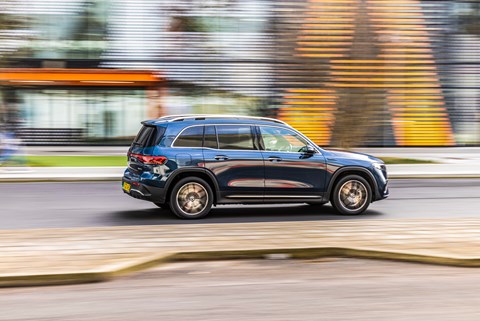
Best for families looking for a versatile, electric SUV with a touch of luxury.
Pros: Seven seats, impressive ride, efficient
Cons: Creaky interior, not much as standard
Merc’s baby SUV, the EQB, almost gets an entrance into this list by default for one reason: it has seven seats. There are so few seven-seat electric cars out there that, even now, the EQB has an interesting niche almost carved out for itself. True, even Merc says the rearmost seats are for kids only, but they’re still useful.
Powered by a 66.5kWh battery, the EQB promises a WLTP range of up to 260 miles. Two variants, the 300 and 350, offer 225bhp and 288bhp respectively, with a single-motor option set to debut later. Charging capabilities allow for a 10-80% charge in just over 30 minutes at a 100kW rate.
It also helps that it’s very smooth to drive and manages to be efficient on the move helps, too. So much so that the EQB recently won a CAR group test versus the BMW iX1 and Tesla’s Model Y.
Read our full Mercedes EQB review
Porsche Taycan Sport Turismo

Best for those seeking a luxurious EV that doesn’t compromise on performance
Pros: One of the best handling EVs on sale, fast, big range
Cons: Rear space is cosy, not much room for cargo though
Our best family electric cars list is topped off with a pretty tasty car all around. We love the Taycan at CAR – it proved that electric cars could be exciting to drive and proved that Porsche could make an EV that still handled like a Porsche.
Then the brand introduced the Sport Turismo estate, boosting the car’s practicality credentials to no end. While rear space may still be a smidge on the tight side for adults, the added boot room (and the wider hatchback aperture) made an already good, sporty EV a practical one, too.
Read our full Porsche Taycan Sport Turismo review
Porsche Taycan Sport Turismo Lease DealsVIEW OFFER
VW ID.Buzz

Best for those seeking an EV that offers nostalgia, practicality, and modern tech
Pros: Retro looks, spacious, drives like a car
Cons: Long waiting list, iffy range
If you want ultimate space for long journeys, or if you and your family enjoy a lot of outdoor hobbies, there are few cars that can carry quite so much stuff as the Buzz. It’s designed to look very much like the VW Microbus from generations ago and features the same MEB platform as the Enyaq on this list (as well as countless other VW Group products). And, despite it looking very much like a van, it drives very much like a car. Albeit a tall one.
You may be waiting a while if you order one now, and you may be waiting just as long for the incoming seven-seat option, but you’ll get a funky family car that’ll turn heads and take you and the family on plenty of adventures.
Read our full VW ID.Buzz review
Why buy an electric family car? Pros and cons
Pros:
Because there are more family electric car options than ever before as brands electrify. Developing EVs as family cars has meant, in terms of packaging and interior practicality, that many can be as spacious inside as cars with combustion engines. Electric cars usually feature a flat floor, allowing for more space for passengers, as well as more opportunities for storage.
What’s more, electric cars can often make better family vehicles than conventional, ICE-powered cars. Certain EVs, like the Ioniq 5 and Niro EV on this list, can be specified with domestic power sockets, meaning family members can power external devices like laptops straight from the car – handy for longer journeys.

And, speaking of longer journeys, EV ranges and charging speeds are slowly increasing. The UK’s EV charging infrastructure is slowly improving, too. The SMMT (Society of Motoring Manufacturers and Traders) says that, in 2025, the average battery range for an electric car is closing in on 300 miles (up from 210 miles in 2020), and it agrees that almost every segment of the car market has an electric option.
Cons:
Electric cars are still more expensive than their petrol or diesel counterparts. Though prices are coming closer to equalising, parity has yet to be reached, and an equivalently priced EV will not match a petrol car for performance or plushness.
Electric cars do not suit every lifestyle yet. We wouldn’t recommend an EV to anyone who doesn’t have the ability to charge at home – with a 7.4kW wallbox and a permanent parking space.
Relying on expensive public charging alone is dicey unless you’re lucky enough to live in an area that’s well provisioned with charge points. Even if you can top up, you lose much of the running cost advantage of an EV, as public charge points cost much more than regular electricity.
Our verdict
Our favourite small car on this list is the MG4 EV – our sister site, Parkers.co.uk, even awarded it their best small family car and overall Car of the Year trophy for 2024.
Small electric cars can still be very practical, with flat floors and useful boots, but do make sure you can fit all your family’s paraphernalia before you buy.
How we test
Every car we get our hands on goes through a rigorous testing process. We’ll examine every aspect of it, from how much space there is in each individual seat to how many suitcases you can fit in the boot.
When rating the way a car drives, our team will dip into a combined century-worth of testing experience to gauge how it stacks up. We’ll examine how competent or easy to use the gearbox is, whether the engine has the appropriate amount of poke for the price, and where the car sits in the context of its rivals.
We push and prod interiors to find imperfections, run batteries flat in search of true EV efficiency ratings and constantly share findings amongst each other to keep our senses on the straight and narrow. Then, once we’ve gathered all the information we need, we’ll compile it into a full review and publish right here on CAR.
To find out more about how we put our cars through their paces, be sure to head over to our dedicated how we test cars page.
How much does it cost to charge an electric family car?
EV charging costs can vary wildly, depending on how large the car’s battery is and whether you’re topping up at home or in public.
We’ve got a full guide to EV charging costs that breaks down how much you should expect to pay.
Curtis Moldrich is the digital editor of CAR magazine, and has worked on the brand for six years. He’s driven every car in our electric car guides and driven many more hybrid and ICE cars too.